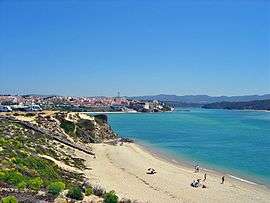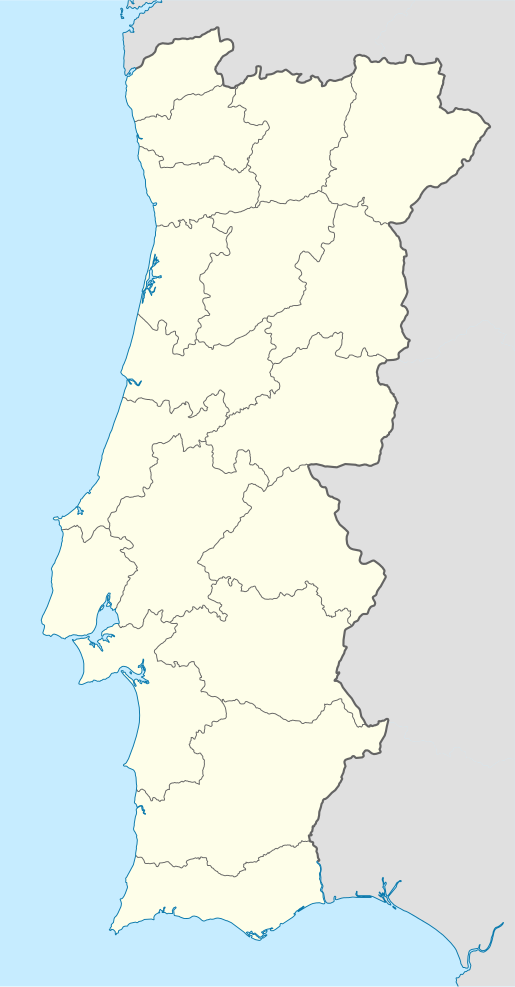Vila Nova de Milfontes
Vila Nova de Milfontes is a civil parish in the municipality of Odemira of the Portuguese Alentejo region. The population in 2011 was 5,031,[1] in an area of 76.48 km².[2]
Vila Nova de Milfontes | |
|---|---|
 The Mira River flows into sea at Vila Nova de Milfontes | |
 Coat of arms | |
 Vila Nova de Milfontes Location in Portugal | |
| Coordinates: 37.725°N 8.781°W | |
| Country | |
| Region | Alentejo |
| Intermunic. comm. | Alentejo Litoral |
| District | Beja |
| Municipality | Odemira |
| Area | |
| • Total | 76.48 km2 (29.53 sq mi) |
| Elevation | 0 m (0 ft) |
| Population (2011) | |
| • Total | 5,031 |
| • Density | 66/km2 (170/sq mi) |
| Time zone | UTC±00:00 (WET) |
| • Summer (DST) | UTC+01:00 (WEST) |
| Postal code | 7645 |
| Area code | 283 |
| Website | http://www.jf-vnmilfontes.pt/ |
History
One of the older parishes in the municipality, it was founded in 1485 by King John II, the area was constituted to serve an economic and defensive role in the Alentejo, at the confluence of the Mira River, and benefited from its strategic importance as a safe harbour. The first inhabitants were prisoners sentenced by minor crimes; 50 years after it was established the population of the parish was little more than ten families.
The village was frequently attacked by pirates, and destroyed completely in 1590, resulting in the construction of fortress, around 1602: the Fort of São Clemente (Portuguese: Forte de São Clemente), which was constructed between 1599 and 1602 (during the reign of King Phillip II).
During the 19th century, the parish was integrated into the municipality of Odemira, during the administrative reforms of Mouzinho da Silveira.
Vila Nova do Milfontes was involved in Portuguese aviation, being one of the first points between Portugal and Macau, completed by Brito Paes (a citizen of Colos in Vila Nova de Milfontes) and Sarmento Beires. On 7 April 1924, these pilots left Campo dos Coitos, near Milfontes on their voyage to the Far East. In homage to the aviators and their historic flight, in the Praça da Barbacã (alongside the fort), a monument was erected to mark their voyage.
Geography
Vila Nova de Milfontes is located along the western coast of Atlantic Ocean on the northern margin of the Mira River, falling within the Nature Park of the Southwest Alentejo and Vicentine Coast. Vila Nova de Milfontes is dominated by a large estuary and ecosystem, dominated by the Mira River that gives shelter to several species of birds and marine life, in addition to wild boar and fox in the surrounding woods.
Beaches
There are several beaches near the urban areas that regularly attract tourists:
- Malhão
- Praia da Franquia (also known as Praia do Rio)
- Furnas
- Aivados
- Ribeira da Azenha
- Foz
Economy
Along the river, the small fishing port is still maintained, provide a small source of income. In fact, the region has developed an aquaculture centre nearby in Moinho da Asneira.
Moreover, sport fishing, diving, pedestrian trails, horse trails and all-terrain sports are promoted for amateur tourists, supported by a local service economy designed on tourism. Moreover, the surrounding area offers ecological tourism, paragliding training, a small safari park and beautiful hideouts with small waterfalls. The tourist-oriented town, with only a small population, annually becomes inflated during the summer and holiday seasons, tourists attracted by the white sand beaches, clear water and landscape.
Notable citizens
- António Jacinto da Silva Brito Pais (Colos, 15 July 1884 - 22 February 1934), military officer and pilot; Brito Pais joined the Escola do Exército in 1907, becoming an infantryman and serving in the 5th Battalion and Niassa company, before returning to Portugal in 1912 (due to illness). He participated in combat in World War One, with the 15th Infantry of the Corpo Expedicionario de Portugal (Portuguese Expeditionary Corp), where he received the War Cross and French Legion of Honour. At the end of the War he was assigned the command of the Bombardment and Observation Squadron of the Republic Aviation Squadron, and in 1920, along with Sarmento Beires, made an attempt to link Madeira by air. In 1924, along with Sarmento Beires and Manuel Gouveia, they completed the first air voyage between Portugal and Macau, in their airplane “Pátria”, which departed Vila Nova de Milfontes.
- Custódio Brás Pacheco (1828-1883), politician, journalist and association leader; Pacheco, a tobacco factory worker in Lisbon, in 1878 he became a candidate for the Republican Party during that year's elections. In 1879, he founded the newspaper A Voz do Operário, which later gave rise to the Sociedade A Voz do Operário (later the Sociedade de Instrução e Beneficência “A Voz do Operário”). He would go on to found or collaborate in several associations, including: Centro Promotor dos Melhoramentos das Classes Laboriosas; Associação Fraternidade Operária; and Associação de Socorros Mútuos União Fraternal dos Operários da Fabricação dos Tabacos (in the last one he was a director, for several years).
- António Mantas (1875-1939), politician; an adopted son of Vila Nova de Milfontes, he married Aurora Prado, daughter of a property-owner and industrialist in Odemira, inheriting a home Milfontes, where he lived. During a decade, he was active in local affairs, supporting the interests of Milfontes, in particular, improvements to the navigability of the Mira River, when boats had a tendency to scrape the bar.
Gallery
 Side street in Vila Nova de Milfontes
Side street in Vila Nova de Milfontes View of the Mira River
View of the Mira River Live entertainment in the town square
Live entertainment in the town square Arcanjo Statue
Arcanjo Statue Beaches along the Mira River
Beaches along the Mira River Colorful buildings line the quiet streets
Colorful buildings line the quiet streets View towards the Atlantic Ocean
View towards the Atlantic Ocean
References
- Instituto Nacional de Estatística Archived November 15, 2016, at the Wayback Machine
- Áreas das freguesias, concelhos, distritos e país